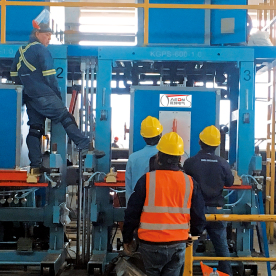Induction heating equipment is rapidly gaining traction across various industries due to its efficiency, precision, and environmentally friendly characteristics. This innovative technology heats materials through electromagnetic induction, making it an essential tool in modern manufacturing processes. In this article, we will delve into the principles of induction heating, its advantages, diverse applications, and future trends that could shape its evolution in the coming years.

Exploring the Advantages, Applications, and Future Trends of Induction Heating Equipment in Modern Manufacturing Processes
Understanding Induction Heating
At its core, induction heating relies on generating heat within a conductive material by exposing it to an alternating magnetic field. When an alternating current flows through a coil, it produces a changing magnetic field. When a conductive material such as metal is introduced into this field, eddy currents are induced within it, causing the material to heat up due to its electrical resistance. This method allows for rapid heating of the workpiece, often without direct contact or the need for a heated element.

Exploring the Advantages, Applications, and Future Trends of Induction Heating Equipment in Modern Manufacturing Processes
Advantages of Induction Heating Equipment
1. **Efficiency**: One of the most significant benefits of induction heating is its energy efficiency. Since the heating occurs directly within the material, there is minimal heat loss to the surrounding environment. This efficiency translates into lower energy costs and reduced carbon footprints, making it an attractive option for manufacturers looking to improve sustainability.
2. **Precision**: Induction heating equipment offers unparalleled control over temperature and heating rates. This precision allows manufacturers to achieve consistent results and minimize defects in the production process. Operators can easily adjust parameters to suit specific applications, leading to higher quality products and reduced scrap rates.
3. **Speed**: The rapid heating capabilities of induction heating equipment significantly reduce cycle times in manufacturing processes. This speed is particularly advantageous in high-volume production environments where time efficiency directly correlates to profitability.
4. **Safety**: Unlike traditional heating methods, induction heating minimizes the risks associated with open flames and high-temperature surfaces. As the heat is generated inside the material, the exterior remains relatively cool, reducing the likelihood of burns or other thermal hazards for operators.
5. **Versatility**: Induction heating equipment can be used across various applications, including hardening, melting, forging, brazing, and annealing. This versatility makes it suitable for multiple industries, from aerospace to automotive, and energy to electronics.
Applications of Induction Heating Equipment
Induction heating equipment finds applications in several sectors, including:
– **Automotive Industry**: In automotive manufacturing, induction heating is used for various purposes, such as preparing components for joining through brazing, hardening gears and shafts, or even melting metals for casting. Its efficiency greatly benefits automotive assembly lines.
– **Metalworking**: Induction heating plays a crucial role in metalworking applications, including forging and heat treatment. It allows for precise control over the heating process, which is essential for achieving the desired material properties.
– **Electronics Manufacturing**: In the electronics realm, induction heating has become a preferred method for soldering components onto circuit boards. The ability to apply localized heat without damaging surrounding parts enhances product reliability and performance.
– **Food Industry**: Although less common, induction heating is making headway in food processing, specifically for cooking and pasteurization due to its efficiency and cleanliness.
Future Trends in Induction Heating
As industries continue to embrace automation and smart technologies, the future of induction heating equipment holds exciting prospects. Here are some trends to watch for:

Exploring the Advantages, Applications, and Future Trends of Induction Heating Equipment in Modern Manufacturing Processes
– **Integration with IoT**: The adoption of Internet of Things (IoT) technology in induction heating systems will enable advanced monitoring and control. Manufacturers will be able to track performance, predict failures, and optimize processes in real time.
– **Advancements in Materials**: New materials that improve the efficiency and performance of induction heating equipment are being developed. Researchers are focusing on designing coils and power supplies that can produce stronger electromagnetic fields, enabling faster and more efficient heating.
– **Growing Demand for Sustainability**: As global awareness of environmental issues grows, industries are increasingly looking for sustainable manufacturing processes. Induction heating, which leads to lower energy consumption and carbon emissions, is poised to meet this demand.
– **Customized Solutions**: With industries requiring more specialized applications, manufacturers are moving toward creating customized induction heating systems. Tailored solutions can better address the specific needs of individual clients, enhancing efficiency and productivity.
In conclusion, induction heating equipment offers a myriad of advantages that appeal to modern manufacturers. Its combination of efficiency, precision, and versatility makes it a key player in advancing manufacturing practices. As technology continues to evolve, the future of induction heating promises to be bright, showcasing its potential to revolutionize various industries further.Industrial All-in-one High Frequency Welder


